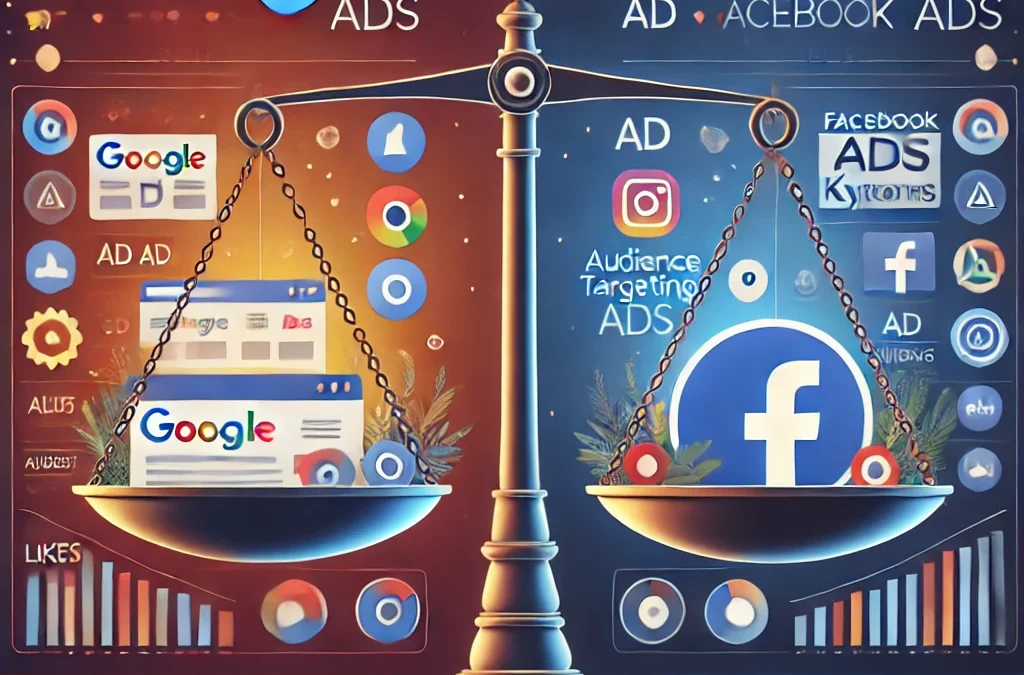Google Ads vs. Facebook Ads: Which One is Right for Your Small Business?
In today’s competitive digital landscape, small businesses need to invest wisely in online advertising to reach their target audience and drive sales. Google Ads and Facebook Ads are two of the most popular platforms for online advertising, each offering unique benefits. But how do you know which one is right for your business?
This guide will break down the differences between Google Ads and Facebook Ads, compare their features, and help you decide which platform best suits your small business’s goals, budget, and audience.
The Basics: What Are Google Ads and Facebook Ads?
Google Ads
Google Ads is a pay-per-click (PPC) advertising platform that allows you to create text, display, shopping, and video ads that appear across Google’s search results and its extensive Display Network. With Google Ads, you can target users who are actively searching for specific products, services, or solutions.
- Key Features:
- Search Ads: Appear at the top of Google search results when users search for specific keywords.
- Display Ads: Visual banner ads that appear across websites in Google’s Display Network.
- Shopping Ads: Product-based ads that display when users search for products.
- Video Ads: Video content shown on YouTube and other Google partner websites.
- How It Works: Google Ads operates on a bidding system where advertisers bid on keywords that users type into the search engine. The higher your bid (and the better your ad quality), the more likely your ad is to appear prominently on the results page.
Facebook Ads
Facebook Ads allows you to run paid advertising campaigns on Facebook, Instagram, Messenger, and Audience Network. Facebook’s strength lies in its detailed audience targeting, which helps you reach users based on their interests, behaviors, demographics, and even interactions with your business.
- Key Features:
- Image and Video Ads: Ads that appear in users’ feeds or stories on Facebook, Instagram, and Messenger.
- Carousel Ads: Multiple images or videos users can scroll through within a single ad.
- Lead Ads: Ads designed to capture user information without leaving Facebook or Instagram.
- Retargeting Ads: Ads that appear to users who have already interacted with your brand or visited your website.
- How It Works: Facebook Ads focuses on audience targeting. Rather than targeting keywords like Google, Facebook allows you to reach users based on detailed demographic, interest, and behavioral data. You can even target lookalike audiences who share similar characteristics with your existing customers.
Google Ads vs. Facebook Ads: Key Differences
Both platforms offer powerful advertising tools, but their differences make each one suited for specific types of campaigns. Here’s a detailed comparison:
1. Audience Targeting
- Google Ads: Google Ads is intent-driven, meaning it targets users who are actively searching for something specific. You bid on keywords that match the search terms your potential customers are using. This is great for capturing users with high purchase intent.
- Facebook Ads: Facebook Ads uses interest-based targeting, allowing you to target users based on their demographics, behaviors, and interests. You can target very specific groups of people, even those who may not be actively searching for your products but are likely to be interested in them.
Best for:
- Google Ads is ideal for capturing users with intent who are further along in the buying process.
- Facebook Ads excels at reaching users who may not be searching for your products but are interested in them based on their lifestyle, behaviors, and preferences.
2. Ad Formats
- Google Ads: Primarily text-based for search ads, but also supports visual formats like display, shopping, and video ads (YouTube). Google Ads’ search format is best for driving immediate action (clicks, sales), while display ads are better for brand awareness.
- Facebook Ads: Facebook Ads are highly visual, relying on images, carousels, and videos to capture attention. Facebook and Instagram’s image and video formats are engaging and offer more options for creative storytelling. Additionally, retargeting options allow advertisers to reconnect with users who have shown interest in their products or services.
Best for:
- Google Ads is better for straightforward, text-based ads focused on search intent.
- Facebook Ads is ideal for visually-driven campaigns where images and videos can tell a compelling brand story.
3. Cost and Bidding System
- Google Ads: Google Ads typically has a higher cost-per-click (CPC) because the competition for keywords can be intense, especially in industries like legal, finance, and e-commerce. However, if your targeting is refined and your ad quality is high, the return on investment can be significant.
- Facebook Ads: Facebook Ads generally have a lower CPC than Google Ads, especially for businesses targeting a broad audience. Since Facebook allows for more granular targeting based on demographics and behaviors, you can reach niche audiences without necessarily competing for high-cost keywords.
Best for:
- Google Ads is suited for businesses willing to invest in higher CPC for high-intent users.
- Facebook Ads is better for businesses with smaller budgets that want to experiment with lower-cost, highly targeted campaigns.
4. Intent vs. Discovery
- Google Ads: Users on Google are typically searching for something specific, whether it’s a product, service, or information. This makes Google Ads intent-based, meaning users are more likely to take action if they find what they’re looking for.
- Facebook Ads: Facebook is a discovery platform. Users aren’t actively searching for products but rather discovering them as they browse their feed. Facebook Ads are more interruptive, meaning you need to capture attention with engaging visuals and compelling messaging.
Best for:
- Google Ads is better for capturing high-intent users ready to make a decision.
- Facebook Ads is great for discovery-based marketing and nurturing interest over time.
5. Analytics and Tracking
- Google Ads: Offers robust analytics through Google Analytics and Google Ads reports, including detailed insights on keyword performance, conversions, and user behavior. You can track how users interact with your ads and follow them across multiple touchpoints, from ad click to purchase.
- Facebook Ads: Provides detailed analytics through Facebook Ads Manager, including insights on ad engagement, reach, impressions, and audience demographics. You can also use Facebook Pixel to track actions taken on your website after users see or click on your ad, making retargeting easier.
Best for:
- Google Ads excels at detailed conversion tracking and keyword performance analysis.
- Facebook Ads provides excellent demographic insights and retargeting options.
Choosing the Right Platform for Your Business
When to Use Google Ads
- If your business relies on search intent: Google Ads is perfect if your product or service is something people are actively searching for (e.g., emergency plumbers, e-commerce products, or local services).
- For immediate results: If you need to capture leads quickly and know that people are searching for your product, Google Ads can bring fast results, provided you have a competitive bid strategy.
- For high-intent keywords: If your business thrives on capturing users who are ready to make a purchase, Google Ads’ search format offers a direct path to conversions.
When to Use Facebook Ads
- If your business relies on visuals: Facebook Ads are ideal for brands that can capture attention with images or videos. For example, fashion, lifestyle, and food brands can thrive on Facebook and Instagram’s highly visual platforms.
- For brand awareness: Facebook Ads are excellent for building awareness and creating a community around your brand. If you’re trying to tell your brand story or promote a lifestyle, Facebook is the place to do it.
- For building a following: If your business is in its early stages and you’re focused on growing a customer base or social media following, Facebook Ads’ low-cost targeting options allow you to get in front of potential customers.
Can You Use Both?
Yes, many businesses successfully use both Google Ads and Facebook Ads to cover both search intent and discovery marketing. For example, you might use Google Ads to target users who are actively searching for products, while using Facebook Ads to build brand awareness and reach a broader audience that hasn’t yet discovered your business.
Strategy Example:
- Google Ads: Run search ads targeting high-intent keywords to drive immediate traffic to your website.
- Facebook Ads: Run retargeting ads for users who visited your website but didn’t convert, showing them relevant product images and offers on Facebook or Instagram.
Final Thoughts
Both Google Ads and Facebook Ads offer unique advantages for small businesses, and the best platform depends on your goals, budget, and audience. If you’re focused on capturing intent-based searches, Google Ads is a powerful tool. On the other hand, if you want to build brand awareness and engage with your audience visually, Facebook Ads is a great choice.
For most small businesses, experimenting with both platforms can provide the best results, allowing you to leverage the strengths of each platform to drive sales, generate leads, and grow your business.
This comprehensive guide outlines the key differences between Google Ads and Facebook Ads and provides insights on when to use each platform. By understanding the strengths and limitations of each, you can create a more effective online advertising strategy tailored to your small business’s needs.


